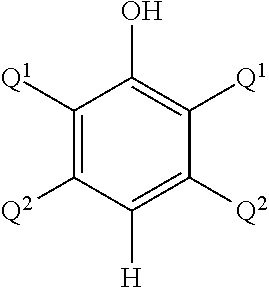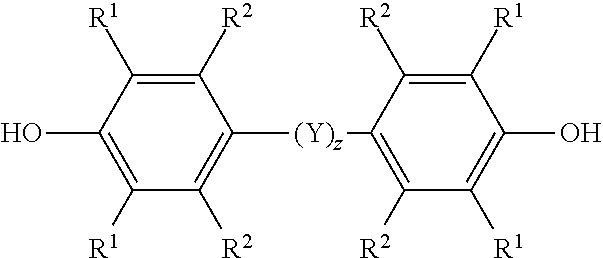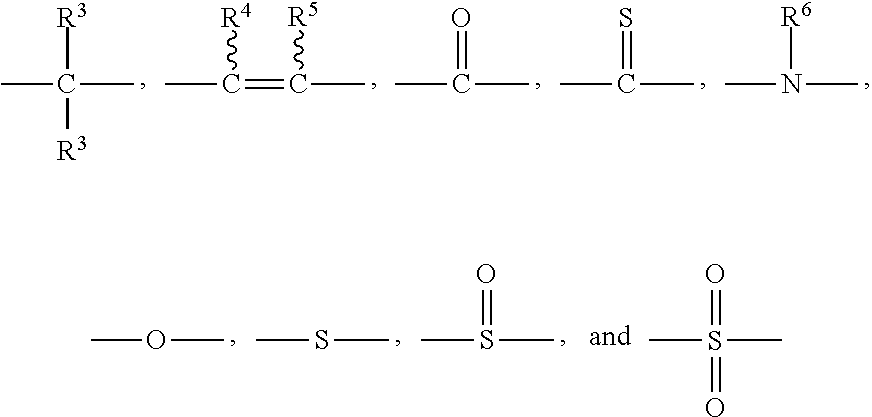Poly(phenylene ether)/epoxy homogeneous solid and powder coating composition incorporating same
a technology of phenylene ether and poly(phenylene ether) is applied in the direction of polyether coating, epoxy resin coating, coating, etc., and can solve the problems of poor surface quality of cured powder coating, difficult to finely disperse a poly(phenylene ether) with other components of the epoxy-containing powder coating resin formulation, and inability to achieve high softening temperature of solid resins
- Summary
- Abstract
- Description
- Claims
- Application Information
AI Technical Summary
Benefits of technology
Problems solved by technology
Method used
Image
Examples
examples 1-46
, COMPARATIVE EXAMPLES 1-40
[0077]These examples illustrate the preparation of solid solutions consisting of hydroxy-diterminated poly(phenylene ether) and epoxy resin. Materials used in these examples are summarized in Table 1.
[0078]
TABLE 1NameDescriptionPPE-2OHCopolymer of 2,6-dimethylphenol and 2,2-bis(3,5-dimethyl-4-hydroxyphenyl)propane, CAS Reg. No. 1012321-47-9, having anumber average molecular weight of 1680 atomic mass units, anaverage of 1.9 hydroxyl groups per molecule, and a glass transitiontemperature of about 145° C.; obtained as NORYL ™ SA90 Resinfrom SABIC Innovative Plastics.Epoxy 12,2-Bis(4-hydroxyphenyl)propane-epichlorohydrin polymer, a highviscosity liquid epoxy resin having an epoxide equivalent weight of175 grams per equivalent; obtained as D.E.R. ™ 332 Liquid EpoxyResin from Dow Chemical.Epoxy 22,2-Bis(4-hydroxyphenyl)propane-epichlorohydrin polymer, a solidepoxy resin having an epoxide equivalent weight of 185 grams perequivalent obtained as EPON ™ Resin 828 ...
examples 47-49
, COMPARATIVE EXAMPLES 41-42
[0090]These examples illustrate the preparation of powder coating resins using the epoxy / poly(phenylene ether) homogeneous solids. Materials used in these examples are summarized in Table 11.
[0091]
TABLE 11NameDescriptionEpoxy 52,2-Bis(4-hydroxyphenyl)propane-epichlorohydrin copolymer, a highmolecular weight Type 8 solid epoxy resin having an epoxide equivalentweight of 702 grams per equivalent; obtained as D.E.R. ™ 6224 SolidEpoxy resin from Dow Chemical.Epoxy 7Polyglycidyl ether of ortho-cresol novolac, a solid epoxy resin having anepoxide equivalent weight of 217 grams per equivalent; obtained asEPON ™ Resin 164 from Momentive Specialty Chemicals.Epoxy 82,2-Bis(4-hydroxyphenyl)propane-epichlorohydrin copolymer, a lowmolecular weight solid epoxy resin having an epoxide equivalent weightof 840 grams per equivalent, containing 10 weight percent of apolyacrylate flow modifier; obtained as D.E.R. ™ 6330-A10 Solid EpoxyResin from Dow Chemical.HardenerDicyandi...
PUM
| Property | Measurement | Unit |
|---|---|---|
| glass transition temperature | aaaaa | aaaaa |
| glass transition temperature | aaaaa | aaaaa |
| glass transition temperature | aaaaa | aaaaa |
Abstract
Description
Claims
Application Information
 Login to View More
Login to View More - R&D
- Intellectual Property
- Life Sciences
- Materials
- Tech Scout
- Unparalleled Data Quality
- Higher Quality Content
- 60% Fewer Hallucinations
Browse by: Latest US Patents, China's latest patents, Technical Efficacy Thesaurus, Application Domain, Technology Topic, Popular Technical Reports.
© 2025 PatSnap. All rights reserved.Legal|Privacy policy|Modern Slavery Act Transparency Statement|Sitemap|About US| Contact US: help@patsnap.com



